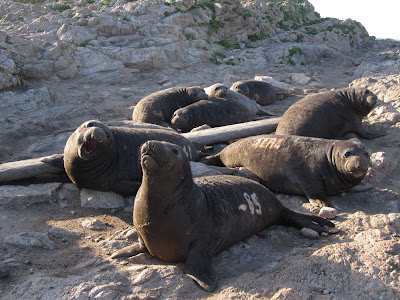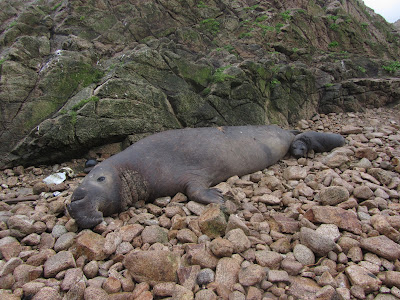January Showers Bring February Flowers and a Weaner Pod with Superpowers
March 2, 2011
We’re starting to notice veritable signs of spring here on Southeast Farallon Island (SEFI). The endemic Farallon Weed covering the island has morphed into a carpet of golden flowers. Some of the seabirds, such as the Pelagic and Brandt’s cormorants, are starting to display their breeding plumage. The Pelagic cormorants exhibit a white patch on the flank behind each wing which is very obvious in flight, as well as a red patch on the face and tufted feathers on the head. We have also seen several Brandt’s cormorants with white whiskery plumes on their heads. And the elephant seal breeding season is heading towards its end. The last new pup of the season was born on February 7, and all but 4 of the pups on the island have been weaned. Currently, there are 55 weaned and 4 nursing pups on SEFI. We’ve also found 12 total weaners and 4 nursing pups on West End.
 |
| Miner’s lettuce and Farallon Weed in bloom |
 |
| Pelagic cormorant sporting breeding plumage |
 |
| Weaner pod |
Since they are often chased around by the last of the protective mothers and belligerent males, the weaners have started clustering in one half of Sand Flat, often in small groups called ‘weaner pods.’ Although they spend most of their time sleeping, some of the weaners are beginning to interact with each other, with the males clumsily play-fighting. They will remain at their natal colony for up to two and a half months before they leave for their first long foraging trip out to sea. During the time that they are here, the weaners will fast while learning to swim in shallow water. So far, the thick blubber layer that they have accumulated during a month of nursing has impeded their mobility, and they clumsily roll and bounce about the rocky terrain. They are unable to move very quickly, and a few of the weaners have been gravely injured by falling in the way of charging breeding bulls. MC Hammer has singlehandedly killed four weaners within his territory at Mirounga Beach with deep gashes to the head. Most of the attacks happened on the days that those pups were weaned, and we are not sure why he has targeted these relatively helpless animals, many of which are probably his own offspring. They may have gotten in his way when he was mating with the cows, or it may simply be displaced aggression. We have not witnessed any other subadult or adult males injuring weaned pups in the same way, especially not our Sand Flat ‘lovebug’ Rusty.
 |
| Weaner pod staying out of harm’s way up on Omega Terrace |
 |
| Play-fighting |
 |
| Rusty with cow and pup |
We’ve seen a few success stories too. Several of the Sand Flat weaners have been washed out from the area during high swells, and a couple have fallen into Breaker Cove at the edge of the territory. We considered them as good as gone, but surprisingly, we’ve been finding the ‘lost’ weaners all around the island. One ended up on West End, a couple on Weather Service Peninsula between West End and Sand Flat, and some in gulches on the East and North sides of SEFI. Some have disappeared from Sand Flat and reappeared at other places on the island, returning to their natal beach several days later. While they may not be strong or experienced enough yet to undertake their first long trip to sea, they apparently have the capacity to remain afloat and even to swim back home after getting washed up on other beaches. We keep wondering how they get to where they end up, and imagine them setting ‘sail’ around the island.
 |
| ‘Missing’ weaner with subadult male on Weather Service Peninsula |
We have been tagging each of the pups as soon they wean, as well as measuring their length and girth to gain an estimate of nursing and weaning success. The measurements have been fairly consistent between the animals, ranging from 140 cm to 160 cm for length and 127 cm and 147 cm for girth. Similarly to previous years, we’ve found tha
t the weaners born on Marine Terrace are larger than those born on the crowded sand flat. With the weaners being almost as large around as they are long, they will have to lose some of their ‘baby fat’ before they can navigate the water. Some weaners, however, are not always ready to start losing weight once they lose their mother. One of the weaners in Mirounga Beach had found a surrogate mother and suckled for an additional 19 days from its second mom. It became what we call a ‘superweaner, or ‘double mother suckler.’
Several of the males that are subordinate to the alphas Rusty and MC Hammer spent the warm days waiting in the alley for cows to come seeking shade. There, they were able to mate with the females without being chased off by a dominant bull. As more cows became sexually receptive, the competition between males for access to them had intensified. At the height of the season, Rusty was unable to hold down the entirety of the Sand Flat territory, and many other subordinate males were able to sneak into the periphery and copulate with females leaving the colony to return to sea. After mating with the alpha male, the cows were often ambushed by at least one other male on the way back to the water. Several of the younger subadult males, often emboldened by the older guys’ pursuits, unsuccessfully tried to sneak into the colony. We often found them later in the day resting on the terrace overlooking Sand Flat with large gashes and puncture wounds on the backs, being unable to do anything other than watch and long for the rocky, cow-filled pastures below. They’ll have to wait a few more years before they can square off with the major game players. For (a lot) more photos of the elephant seals and a personal account of an intern’s experience on the Farallons, you can check out
smellephantisland.
 |
| Subadult male on Marine Terrace |
The winter season is almost at an end, with the elephant seal crew getting ready to leave the island in a week and a half. Like the elephant seals, the winter biologist and interns must return to their true homes. Everyone is quite wistful about leaving, but are enjoying their last days with the seals and each other. It has been a great experience for everyone new to the island, and most of us hope to return here again soon.